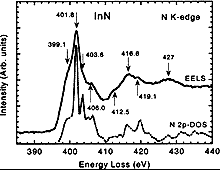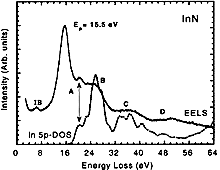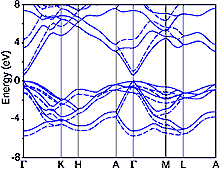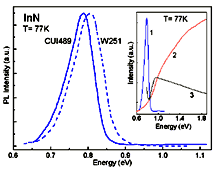 |
InN, Wurtzite (hexagonal). Photoluminescence spectra for samples
with different electron concentrations:
n ~ 9x1018 cm-3 (MOMBE grown sample CUI489);
n ~1.2x1019 cm-3 (PAMBE grown sample W251).
The inset shows the spectra for the sample with electron concentrations
of n ~ 9x1018 cm-3 (CUI489):
1 - photoluminescence;
2 - optical absorption;
3 - photoluminescence excitation.
Davydov et al. Phys. Stat. Solidi (b)
229 (2002a), R1
Contact authors: Valery
Yu. Davydov
Remark. It was the first observation of
edge photoluminescence in near-infrared region in single-crystalline InN
. |
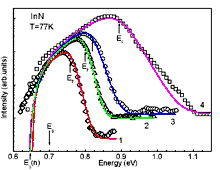 |
InN, Wurtzite (hexagonal). Photoluminescence spectra of
InN layers with different carrier concentrations.
1 - n = 6x1018 cm-3 (MOCVD grown sample);
2 - n = 9x1018 cm-3 (MOMBE grown sample);
3 - n = 1.1x1019 cm-3 (MOMBE grown sample);
4 - n = 4.2x1019 cm-3 (PAMBE grown sample).
Solid lines show the theoretical fitting cures based on a model of interband
recombination in degenerated semiconductors. As a result, the true value
of InN band gap Eg~0.7 eV was established.
Davydov et al. Phys. Stat. Solidi (b)
230 (2002b), R4
Contact authors: Valery
Yu. Davydov
|
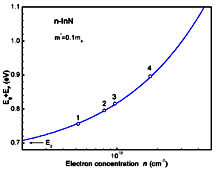 |
InN, Wurtzite (hexagonal). Calculated shift of optical absorption edge
due to the Burstein-Moss effect in n-type InN (solid line) vs. electron
concentration.
The parabolic conduction band with an effective electron mass of m*=0.1
mo is assumed.
Open circles present the values ( Eg + EF) estimated
from the fitting of photoluminescence spectra.
Davydov et al. Phys. Stat. Solidi (b)
230 (2002b), R4
|
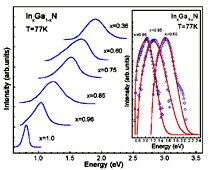
|
In-rich InxGa1-xN alloys. Photoluminescence
spectra of layers with different compositions at T=77 K.
The inset shows the semilog photoluminescence spectra of most perfect alloys
and the fitting cures of the spectra based on a model interband recombination
in degenerated semiconductors .
Davydov et al. Phys. Stat. Solidi (b)
230 (2002b), R4
Remark. It was the first observation of
edge photoluminescence in single-crystalline in-rich InxGa1-xN
alloys (0.36<x<1).
|
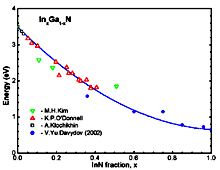
|
InxGa1-xN alloys. The Eg valus
estimated for In-rich alloys (full blue circles, this work), and positions
of photoluminescence band maxima in Ga-rich alloys (open symbols) as a function
of InxGa1-xN composition.
Composition dependence of the band gap (solid line) is fitted by equation
Eg(x)=3.493 - 2.843x - bx(1-x) with a bowing parameter
b=2.5 eV.
Refs.: M. H. Kim, J. K. Cho et al., Phys. Stat. Sol.(a) 176,
269 (1999);
K. P. O'Donnell et al., J. Phys. Condens. Matt. 13, 6977 (2001)
;
A. Klochikhin, A. Reznitsky et al., Nanostructures: Physics and Technology,
Ioffe Institute, St. Petersburg 2001, p.554.
Davydov et al. Phys. Stat. Solidi (b)
230 (2002b), R4 |
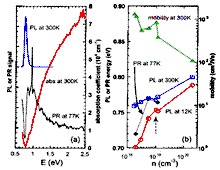 |
InN, Wurtzite (hexagonal). (a) Optical absorption (300 K),
photoluminescence (300 K), and PR (77 K) spectra. This sample is undoped
with room-temperature electron concentration of n=5.48x1018 cm-3.
The spike on the PR spectrum at 0.97 eV is an artifact due to the light
source used in the PR measurement.
(b) Room-temperature mobility, photoluminescence peak energy (300
and 12 K), and the critical energy determined by PR (77 K)
as a function of free-electron concentration n.
The sample with n=1x1019 cm-3 (indicated by a broken arrow) is the
Ritsumeikan sample.
Wu J., Walukiewicz W. et al. Appl. Phys. Lett.
80 (2002a) 3967
Contact authors: W. Walukiewicz
|
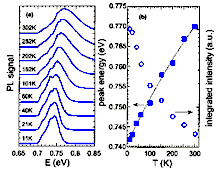 |
InN, Wurtzite (hexagonal). (a) Photoluminescence spectra vs.
temperature (the sample with room-temperature electron concentration
of 5.48x1018 cm-3 . The spectra are normalized to
a constant peak height.
(b) Photoluminescence peak energy and photoluminescence integrated
intensity (log scale) vs. temperature. The line through the peak
energy data is a guide for the eye.
Wu J., Walukiewicz W. et al. Appl. Phys. Lett.
80 (2002a) 3967
|
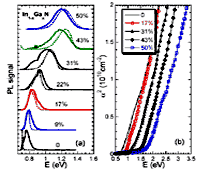 |
In1-xGaxN alloys. (a) Photoluminescence
signal taken at room temperature (solid line) and 11 K (dashed
line) for samples with Ga atomic fraction x ranging from 0% to 50%.
All curves are normalized to equal height and offset vertically for clarity.
(b) Room-temperature absorption coefficient squared as a function
of photon energy.
Wu J., Walukiewicz W. et al. Appl. Phys. Lett.
80 (2002b) 4741
Contact authors: W. Walukiewicz
Remark. An anomalous 'blue' shift
of the photoluminescence peak for InN and In-rich In1-xGaxN
alloys with increasing temperature observed by Wu
J., Walukiewicz W. et al. (2002 a,b) does not agree with normal
'red' shift for InN observed by Davydov
et al. Phys. Stat. Solidi (b) 234 (2002c), 787.
|
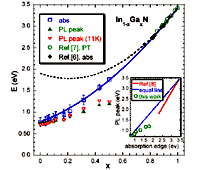 |
In1-xGaxN alloys. Photoluminescence
peak energy and band gap determined by optical absorption vs composition.
Some previously reported data on the Ga-rich side are also shown (Refs.6
and 7). All data are taken at room temperature unless otherwise noted.
The solid curve shows the fit to the band gap energies (abs and PT) by the
equation
Eg(x)=3.42x+ 0.77(1-x) - bx(1-x) with a bowing parameter
b=1.43 eV.
The dashed curve is the fit to the band gap energies on the Ga-rich side
assuming a band gap of 1.9 eV for InN.
Inset: Photoluminescencepeak energy plotted against absorption edge energy.
The solid line is a least-square fit to experimental data on the Ga-rich
side adopted from Ref. 8.
The dashed straight line shows the relation when the Stokes shift is zero.
Ref.6 - Pereira S. et al., Appl. Phys. Lett.
78, (2001) 2137;
Ref.7 - Shan W. et al. J. Appl. Phys. 84, (1998)
4452;
Ref.8 - O'Donnell K.P. et al., Phys. Status
Solidi B 216, (1999) 141.
Wu J., Walukiewicz W. et al. Appl. Phys. Lett.
80 (2002b) 4741 |
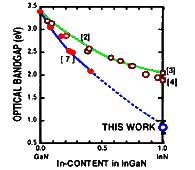
|
InxGa1-xN alloys. The relation between In content
and the band-gap energy.
[2] - Osamura, K., Naka, S., and Murakami, Y., J. Appl. Phys.
46, (1975), 3432.
[3] - Puychevrier N. & Menoret M., Thin Solid Films 36,
(1976), 141.
[4] - Tansley T. L. & Foley C. P., J. Appl. Phys. 59,
(1986), 3241.
[7] - Matsuoka T., Tanaka H., Sasaki T. & Katsui A., Proc. of the Sixteenth
International Symposium on GaAs and Related Compounds, Karuizawa, Japan,
25-29 September 1989, Institute of Physics, Bristol (1990), p.141.
Matsuoka et al. Appl. Phys. Lett. 81,
(2002) 1246
Contact authors: T. Matsuoka |
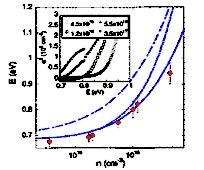
|
InN, Wurtzite (hexagonal). Room-temperature absorption edge vs electron
concentration.
The solid line is the calculated band gap assuming a nonparabolic (EP=10
eV) dispersion for the conduction band and including the band-renormalization
effects.
The dotted-dashed line is the same calculation but without including the
band-renormalization effects.
The dotted line is the result of a calculation assuming a parabolic (m*=0.07mo)
conduction band.
Inset: absorption (squared) curves for four samples with different free-electron
concentrations (in cm-3).
Wu J., Walukiewicz W., Shan W. et al. Phys. Rev. B 66 (2002c),
201403
Contact authors: W. Walukiewicz
|
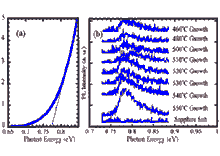
|
InN, Wurtzite (hexagonal).
(a) Optical absorption of InN grown at 550oC at room
temperature;
(b) Photoluminescence spectra of sapphire substrate and InN samples
grown at 460-550oC
Saito et al. Phys. Stat. Solidi
(b) 234 (2002), 796.
Contact authors: Y.
Saito & Y. Nanishi
|
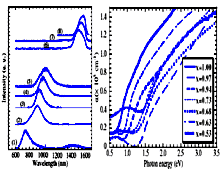 |
InxGa1-xN alloys. (a) Photoluminescence
spectra of films vs. In concentrations x. T=77 K.
(1) - x = 0.37-0.47; (2) - x = 0.53;
(3) - x = 0.63; (4) - x = 0.68;
(5) - x = 0.73; (6) - x = 0.94;
(7) - x = 0.97; (8) - x = 1.00.
(b) Absorption spectra of InxGa1-xN
films vs. photon energy. The temperature T=300 K (high indium
composition region).
Hori et al. Phys. Stat. Sol. (b) 234
(2002) 750
Contact authors: M.
Hori & Y. Nanishi |
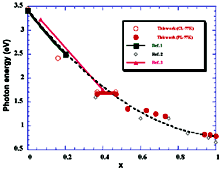 |
InxGa1-xN alloys. Luminescence peak positions
of catodoluminescence and photoluminescence spectra vs. concentration
x.
The plots of luminescence peak positions can be fitted to the curve
Eg(x)=3.48 - 2.70x - bx(1-x) with a bowing parameter
of b=2.3 eV
Ref.1 - Wetzel., Appl. Phys. Lett. 73, 73 (1998).
Ref.2 - V. Yu. Davydov., Phys. Stat. Sol. (b) 230, R4 (2002).
Ref.3 - O’Donnel., J. Phys .Condens. Matt. 13, 1994 (1998).
Hori et al. Phys. Stat. Sol. (b) 234
(2002) 750 |
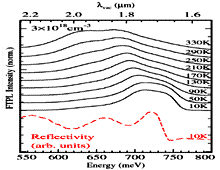 |
InN. PL spectra. The temperature dependence of the resonance
at the position of the Fermi edge for an InN layer doped with n=8x1017cm-3.
Basically two contributions can be seen in PL:
One at the position of the renormalized gap (weak shoulder at ~650meV) and
one at the position of the Fermi edge (~730meV) which is interpreted as
a Mahan exciton.
Feneberg et al., Phys. Rev. B
77 (2008), 245207
Contact authors: Klaus
Thonke & Martin Feneberg
|
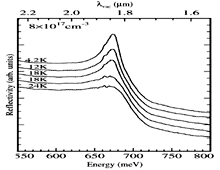 |
InN. A series of reflectance spectra recorded at different temperatures
is shown for a sample with n=3x1018cm-3.
Feneberg et al., Phys. Rev. B
77 (2008), 245207
Contact authors: Klaus
Thonke & Martin Feneberg
These measurements confirm the low bandgap values of ~ 0.7 eV for
InN at low temperature. |

















